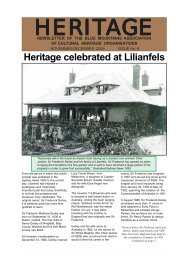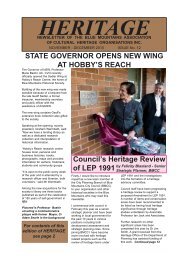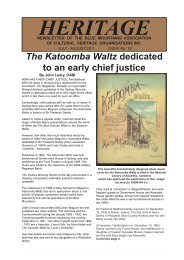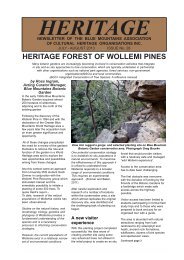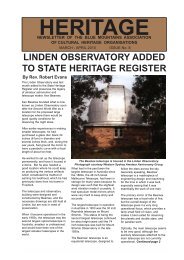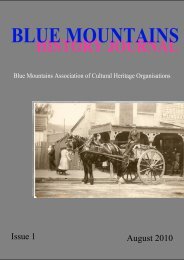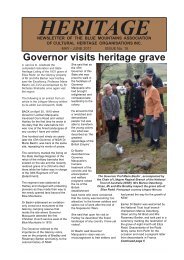Newsletter No - Blue Mountains Association of Cultural Heritage ...
Newsletter No - Blue Mountains Association of Cultural Heritage ...
Newsletter No - Blue Mountains Association of Cultural Heritage ...
Create successful ePaper yourself
Turn your PDF publications into a flip-book with our unique Google optimized e-Paper software.
Lithgow Small Arms Factory to celebratecentenaryLITHGOW Small Arms FactoryMuseum will celebrate thecentenary <strong>of</strong> the establishment <strong>of</strong>the factory which went on to be thesource <strong>of</strong> much <strong>of</strong> Australia’sdefence equipment for World War 1and 2.An exhibition <strong>of</strong> pre-federationcolonial weapons will be presentedby the Lithgow Small Arms FactoryMuseum in conjunction with theAntique Arms Collectors Society <strong>of</strong>Australia from September 20 toOctober 27.A series <strong>of</strong> centenary workshoptalks will be conducted over theweekend October 20-21.For more information on theseactivities contact the Lithgow SmallArms Factory Museum by e-mail tolithgowsafmusesum@ozemail.com.auor by telephone to (02) 6351 4452.BRIEF HISTORY OF THESMALL ARMS FACTORYThe Federation <strong>of</strong> the Australianstates in 1901 resulted in a uniformdefence and armed services policybeing implemented.When the British Army adopted the.303 calibre short, magazine Lee-Enfield rifle for general issue to itsforces colonial governments were“asked” to standardise and submitorders to the UK for the newweapons.It was proposed in Australia that thecountry should be more selfsufficient and manufacture its owndefence needs in its own arsenaland a number <strong>of</strong> sites wereconsidered for Australia’s first riflemanufacturing facility.The government received an <strong>of</strong>fer in1904 by Mr W Sandford <strong>of</strong> EskbankIronworks to lease land, supplycheap coal and prepare his plant toproduce the steel required for themanufacture <strong>of</strong> rifles if Lithgow waschosen.The Lithgow Progress <strong>Association</strong>also made representation to theHonorable Sir Joseph Cook MP onLithgow’s behalf.After considerable investigations bythe defence department andinspection by Lord Kitchener in1909, Lithgow was chosen as thesite to establish a small armsfactory.The ready supply <strong>of</strong> steel and coalfor power were the main factors butit was also believed that Lithgowwas beyond the range <strong>of</strong> the navalguns <strong>of</strong> the day.Engineer Commander WilliamClarkson <strong>of</strong> the Royal AustralianNavy was seconded by the defencedepartment to supervise alloperations.A suitable parcel <strong>of</strong> land waspurchased and the contract to erectthe factory buildings was let to thefirm <strong>of</strong> Jones and Allman early in1910.The contract for the power plantwas given to the State GovernmentDockyard.World wide tenders were called forthe supply <strong>of</strong> suitable plant tomanufacture 1,500 rifles perannum. Despite there being threeBritish tenders, the contract wasawarded to the Pratt & WhitneyCompany <strong>of</strong> Hartford Connecticut.,USA because <strong>of</strong> its assurance itsmachinery was designed for the“American method <strong>of</strong> repetitionmanufacture” which is now knownas “high precision massproduction”. Included in the contractwas the supply <strong>of</strong> machine tools,tooling and gauges as well as thetraining <strong>of</strong> six craftsmen in America.The factory was <strong>of</strong>ficially opened bythe Governor General, BaronDenman on June 8, 1912.The level <strong>of</strong> employment grewrapidly from 25 to 300 in 1913 andthe onset <strong>of</strong> war in 1914 broughtincreased production, extra shiftsand a labour force which reached1,150 by the end <strong>of</strong> hostilities in1918. The factory was the largestemployer in Lithgow and continuedpioneering the techniques <strong>of</strong> massproduction with precision tools andhighly trained personnel whichenabled it to produce all <strong>of</strong>Australia’s weapon needs.Rifle production declined in the1920’s with a resulting reduction inthe work-force but production <strong>of</strong> the.303" Vickers machine guncommenced in a newly erectedbuilding circa 1924 and staffnumbers began to rise.The 1930s’ depression causedmore reductions in staff with thefigure reduced to around 250employees. Despite muchopposition from the private sectorthe factory began to undertakecommercial production in anattempt to retain its workforce andkeep the factory operational.A rifle fan display at the Small Arms Factory, LithgowThis work included the manufacture<strong>of</strong> Western Electric ‘talkie’projectors, reverse engineeredsheep shearing hand-sets,Slazenger golf clubs, spanners,sewing machines, police handcuffsand many other non-military items.Continued page 18HERITAGE 14July - August 2012



